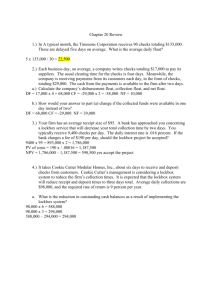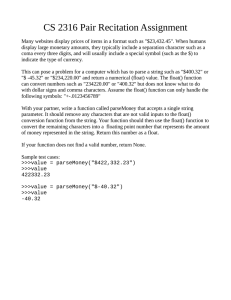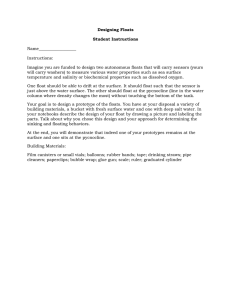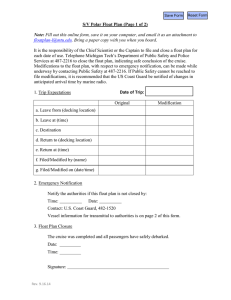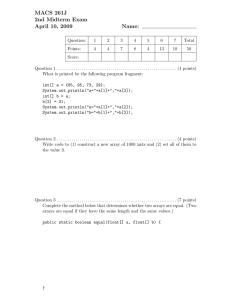CHAPTER19 CASH AND LIQUIDITY MANAGEMENT
advertisement
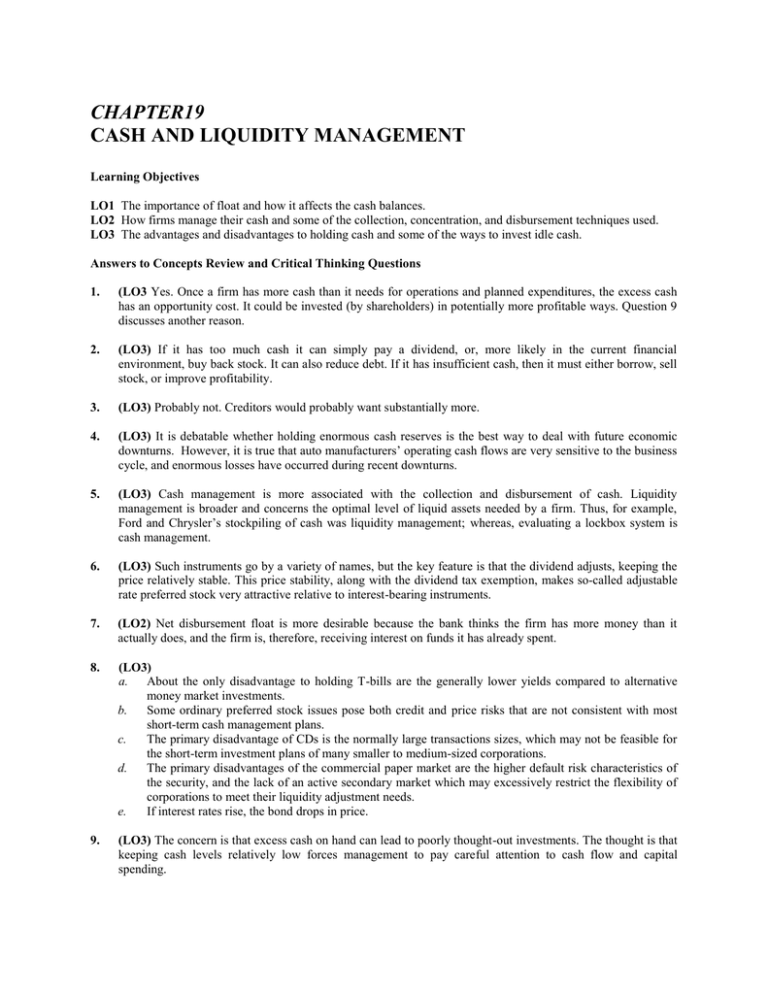
CHAPTER19 CASH AND LIQUIDITY MANAGEMENT Learning Objectives LO1 The importance of float and how it affects the cash balances. LO2 How firms manage their cash and some of the collection, concentration, and disbursement techniques used. LO3 The advantages and disadvantages to holding cash and some of the ways to invest idle cash. Answers to Concepts Review and Critical Thinking Questions 1. (LO3 Yes. Once a firm has more cash than it needs for operations and planned expenditures, the excess cash has an opportunity cost. It could be invested (by shareholders) in potentially more profitable ways. Question 9 discusses another reason. 2. (LO3) If it has too much cash it can simply pay a dividend, or, more likely in the current financial environment, buy back stock. It can also reduce debt. If it has insufficient cash, then it must either borrow, sell stock, or improve profitability. 3. (LO3) Probably not. Creditors would probably want substantially more. 4. (LO3) It is debatable whether holding enormous cash reserves is the best way to deal with future economic downturns. However, it is true that auto manufacturers’ operating cash flows are very sensitive to the business cycle, and enormous losses have occurred during recent downturns. 5. (LO3) Cash management is more associated with the collection and disbursement of cash. Liquidity management is broader and concerns the optimal level of liquid assets needed by a firm. Thus, for example, Ford and Chrysler’s stockpiling of cash was liquidity management; whereas, evaluating a lockbox system is cash management. 6. (LO3) Such instruments go by a variety of names, but the key feature is that the dividend adjusts, keeping the price relatively stable. This price stability, along with the dividend tax exemption, makes so-called adjustable rate preferred stock very attractive relative to interest-bearing instruments. 7. (LO2) Net disbursement float is more desirable because the bank thinks the firm has more money than it actually does, and the firm is, therefore, receiving interest on funds it has already spent. 8. (LO3) a. About the only disadvantage to holding T-bills are the generally lower yields compared to alternative money market investments. b. Some ordinary preferred stock issues pose both credit and price risks that are not consistent with most short-term cash management plans. c. The primary disadvantage of CDs is the normally large transactions sizes, which may not be feasible for the short-term investment plans of many smaller to medium-sized corporations. d. The primary disadvantages of the commercial paper market are the higher default risk characteristics of the security, and the lack of an active secondary market which may excessively restrict the flexibility of corporations to meet their liquidity adjustment needs. e. If interest rates rise, the bond drops in price. 9. (LO3) The concern is that excess cash on hand can lead to poorly thought-out investments. The thought is that keeping cash levels relatively low forces management to pay careful attention to cash flow and capital spending. 10. (LO3) A potential advantage is that the quicker payment often means a better price. The disadvantage is that doing so increases the firm’s cash cycle. 11. (LO3) This is really a capital structure decision. If the firm has an optimal capital structure, paying off debt moves it to an under-leveraged position. However, a combination of debt reduction and stock buy-backs could be structured to leave capital structure unchanged. Solutions to Questions and Problems NOTE: All end of chapter problems were solved using a spreadsheet. Many problems require multiple steps. Due to space and readability constraints, when these intermediate steps are included in this solutions manual, rounding may appear to have occurred. However, the final answer for each problem is found without rounding during any step in the problem. Basic 1. (LO1) The average daily float is the amount of receipts times the average number of days delay, divided by the number of days in a month. Assuming 30 days in a month, the average daily float is: Average daily float = 4($139,000)/30 Average daily float = $18,533.33 2. (LO1) a. The disbursement float is the average monthly checks written times the average number of days for the checks to clear, so: Disbursement float = 4($12,000) Disbursement float = $48,000 The collection float is the average monthly checks received times the average number of days for the checks to clear, so: Collection float = 2(–$23,000) Collection float = –$46,000 The net float is the disbursement float plus the collection float, so: Net float = $48,000 – 46,000 Net float = $2,000 b. The new collection float will be: Collection float = 1(–$23,000) Collection float = –$23,000 And the new net float will be: Net float = $48,000 – 23,000 Net float = $25,000 3. (LO1) a. The collection float is the average daily checks received times the average number of days for the checks to clear, so: Collection float = 3($17,000) Collection float = $51,000 b. The firm should pay no more than the amount of the float, or $51,000, to eliminate the float. c. The maximum daily charge the firm should be willing to pay is the collection float times the daily interest rate, so: Maximum daily charge = $51,000(.00017) Maximum daily charge = $8.67 4. (LO1) a. Total float = 4($14,000) + 3($5,000) Total float = $71,000 b. The average daily float is the total float divided by the number of days in a month. Assuming 30 days in a month, the average daily float is: Average daily float = $71,000/30 Average daily float = $2,366.67 c. The average daily receipts are the average daily checks received divided by the number of days in a month. Assuming a 30 day month: Average daily receipts = ($14,000 + 5,000)/30 Average daily receipts = $633.33 The weighted average delay is the sum of the days to clear a check, times the amount of the check divided by the total receipts, so: Weighted average delay = 4($14,000/$19,000) + 3($5,000/$19,000) Weighted average delay = 3.74 days 5. (LO2) The average daily collections are the number of checks received times the average value of a check, so: Average daily collections = $125(6,400) Average daily collections = $800,000 The present value of the lockbox service is the average daily receipts times the number of days the collection is reduced, so: PV = (2 day reduction)($800,000) PV = $1,600,000 The daily cost is a perpetuity. The present value of the cost is the daily cost divided by the daily interest rate. So: PV of cost = $175/.00016 PV of cost = $1,093,750 The firm should take the lockbox service. The NPV of the lockbox is the cost plus the present value of the reduction in collection time, so: NPV = –$1,093,750 + 1,600,000 NPV = $506,250 The annual savings excluding the cost would be the future value of the savings minus the annual costs, so: Annual savings = $1,600,000(1.00016)365 – 1,600,000 Annual savings = $96,214.42 And the annual cost would be the future value of the daily cost, which is an annuity, so: Annual cost = $175(FVIFA365,.016%) Annual cost = $65,771.58 So, the annual net savings would be: Annual net savings = $96,214.42 – 65,771.58 Annual net savings = $30,442.84 6. (LO1) a. The average daily float is the sum of the percentage each check amount is of the total checks received times the number of checks received times the amount of the check times the number of days until the check clears, divided by the number of days in a month. Assuming a 30 day month, we get: Average daily float = [.60(5,300)($43)(2) + .40(5,300)($75)(3)]/30 Average daily float = $25,016 On average, there is $25,016 that is uncollected and not available to the firm. b. The total collections are the sum of the percentage of each check amount received times the total checks received times the amount of the check, so: Total collections = .60(5,300)($43) + .40(5,300)($75) Total collections = $295,740 The weighted average delay is the sum of the average number of days a check of a specific amount is delayed, times the percentage that check amount makes up of the total checks received, so: Weighted average delay = 2[.60(5,300)($43)/$295,740] + 3[.40(5,300)($75) /$295,740] Weighted average delay = 2.537634408 days The average daily float is the weighted average delay times the average checks received per day. Assuming a 30 day month, we get: Average daily float = 2.537634408 ($295,740/30 days) Average daily float = $25,016 c. The most the firm should pay is the total amount of the average float, or $25,016. d. The average daily interest rate is: 1.07 = (1 + R)365 R = .01854% per day The daily cost of float is the average daily float times the daily interest rate, so: Daily cost of the float = $25,016(.0001854) Daily cost of the float = $4.64 e. The most the firm should pay is still the average daily float. Under the reduced collection time assumption, we get: New average daily float = 1.5($295,740/30) New average daily float = $14,787 7. (LO2) a. The present value of adopting the system is the number of days collections are reduced times the average daily collections, so: PV = 3(385)($975) PV = $1,126,125 b. The NPV of adopting the system is the present value of the savings minus the cost of adopting the system. The cost of adopting the system is the present value of the fee per transaction times the number of transactions. This is a perpetuity, so: NPV = $1,126,125– [$0.35(385)/.00068] NPV = $927,963.23 c. The net cash flows is the present value of the average daily collections times the daily interest rate, minus the transaction cost per day, so: Net cash flow per day = $1,126,125 (.00068) – $0.35(385) Net cash flow per day = $631.02 The net cash flow per check is the net cash flow per day divided by the number of checks received per day, or: Net cash flow per check = $631.02/385 Net cash flow per check = $1.639 Alternatively, we could find the net cash flow per check as the number of days the system reduces collection time times the average check amount times the daily interest rate, minus the transaction cost per check. Doing so, we confirm our previous answer as: Net cash flow per check = 3($975)(.00068) – $0.350 Net cash flow per check = $1.639 per check 8. (LO2) a. The reduction in outstanding cash balance from adopting the lockbox is the number of days the system reduces collection time times the average daily collections, so: Cash balance reduction = 3($130,000) Cash balance reduction = $390,000 b. The dollar return that can be earned is the average daily interest rate times the cash balance reduction. The average daily interest rate is: Average daily rate = 1.091/365 – 1 Average daily rate = .0236131% per day The daily dollar return that can be earned from the reduction in days to clear the checks is: Daily dollar return = $390,000(.000236) Daily dollar return = $92.09 c. If the company takes the lockbox, it will receive three payments early, with the first payment occurring today. We can use the daily interest rate from part b, so the savings are: Savings = $130,000 + $130,000(PVIFA.0236%,2) Savings = $389,907.94 If the lockbox payments occur at the end of the month, we need the effective monthly interest rate, which is: Monthly interest rate = 1.091/12 – 1 Monthly interest rate = 0.7207% Assuming the lockbox payments occur at the end of the month, the lockbox payments, which are a perpetuity, will be: PV = C/R $389,907.94 = C / .007207 C = $2,810.19 It could also be assumed that the lockbox payments occur at the beginning of the month. If so, we would need to use the PV of a perpetuity due, which is: PV = C + C / R Solving for C: C = (PV × R) / (1 + R) C = (389,907.94× .007207) / (1 + .007207) C = $2,790.08 9. (LO2) The interest that the company could earn will be the amount of the checks times the number of days it will delay payment times the number of weeks that checks will be disbursed times the daily interest rate, so: Interest = $86,000(7)(52/2)(.00011) Interest = $1,721.72 10. (LO2) The benefit of the new arrangement is the $5 million in accelerated collections since the new system will speed up collections by one day. The cost is the new compensating balance, but the company will recover the existing compensating balance, so: NPV = $5,000,000 – ($400,000 – 350,000) NPV = $4,950,000 The company should proceed with the new system. The savings are the NPV times the annual interest rate, so: Net savings = $4,950,000 (.025) Net savings = $123,750 Intermediate 11. (LO2) To find the NPV of taking the lockbox, we first need to calculate the present value of the savings. The present value of the savings will be the reduction in collection time times the average daily collections, so: PV = 1.5(800)($750) PV = $900,000 And the daily interest rate is: Daily interest rate = 1.0551/365 – 1 Daily interest rate = .0001467 or .01467% per day The transaction costs are a perpetuity. The cost per day is the cost per transaction times the number of transactions per day, so the NPV of taking the lockbox is: NPV = $900,000 – [$0.15(800)/.0001467] NPV = $81,991.78 Without the fee, the lockbox system should be accepted. To calculate the NPV of the lockbox with the annual fee, we can simply use the NPV of the lockbox without the annual fee and subtract the addition cost. The annual fee is perpetual, so, with the fee, the NPV of taking the lockbox is: NPV = $81,991.78 – [$6,000/.055] NPV = -$27,099.13 With the fee, the lockbox system should not be accepted. 12. (LO2) To find the minimum number of payments per day needed to make the lockbox system feasible is the number of checks that makes the NPV of the decision equal to zero. The average daily interest rate is: Daily interest rate = 1.051/365 – 1 Daily interest rate = .000133681 or .0133681% per day The present value of the savings is the average payment amount times the days the collection period is reduced times the number of customers. The costs are the transaction fee and the annual fee. Both are perpetuities. The total transaction costs are the transaction costs per check times the number of checks. The equation for the NPV of the project, where N is the number of checks transacted per day, is: NPV = 0 = ($5,700)(1)N – $0.10(N)/.000133681 – $10,000/.05 $200,000 = $5,700N – $748.05N $4,951.95N = $200,000 N = 40.39 40 customers per day

